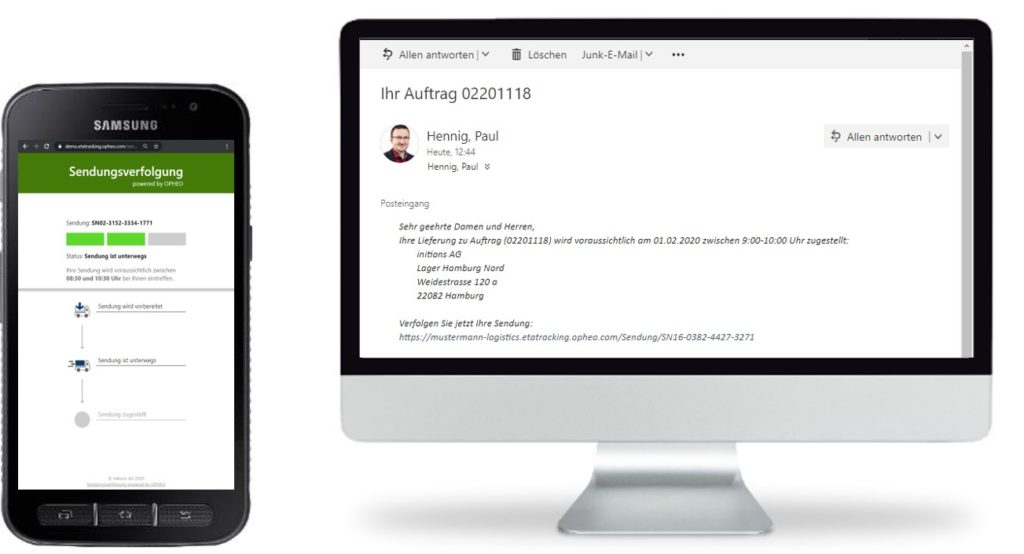
Why digital networking with customers is a must
Amazon, Zalando and CEP service providers have been showing the way in the consumer business for years: Digitalisation simplifies orders, speeds up deliveries and informs customers transparently about the delivery process and expected delivery date. This has increased service quality and customer loyalty.
People’s expectations have long since adapted to these new standards and are also transferring to delivery and ordering processes in B2B business. This is even more true in and after Corona times, where home offices, digital data exchange and low-contact business processes have become leaps and bounds more attractive.
However, both shippers (industrial and retail companies) and logistics providers are still lagging behind these expectations in the B2B business. At the moment, there is therefore still an opportunity to gain decisive advantages over the competition by offering digital networking services to customers. In a few years, however, this situation will turn around: If shippers or logistics providers want to maintain their attractiveness or expand their market position in the long term, they will not be able to avoid this topic. Those who cannot connect their customers digitally will lose out and no longer be competitive. Digital networking is therefore not a nice-to-have, but a must-have.
But how exactly can I offer my customers more in the digital world? Which elements of digital networking create the greatest added value for my customer and for me? Which trends and techniques should I be concerned with? Here, two sets of topics are considered particularly important.
Transparency about the delivery process and arrival time
In B2B business, every shipper and every logistics provider is part of a higher-level and cross-company supply chain. Transparency about the delivery process and especially about the estimated time of arrival (ETA) of a shipment is of great benefit to subsequent actors in the chain. This transparency can be created in various ways.
Bild: iStock (dusanpetkovic)
- Automatic advice
Advices are an active way of informing the customer about the arrival date of their consignment. The personal telephone call is now considered antiquated and is also very time-consuming. Automated e-mails or electronic short messages are now the digital way of choice. - Shipment tracking
Next to notifications, shipment tracking is the second standard that has emerged in customer information. Being able to view the current status of the order or shipment online is already a matter of course in online commerce. In contrast to notifications, where information is “pushed” to the customer, with shipment tracking the customer can decide for themself at any time, when they want to see the status and arrival date of his shipment. - Broadcast Monitor
In the B2B sector, instead of tracking individual consignments, it can also be useful to have an overall view of pending deliveries and their status in the form of a consignment or ETA monitor.
For the customer, all three information channels are about transparency, planning security, optimisation of their own processes and the good feeling of having a future-oriented partner.
However, when establishing a digital notification process or consignment tracking, there are some pitfalls to consider with the software systems used:
- Does the system provide high-quality ETA forecasts that can be used to make reliable arrival forecasts? After all, digital communication channels are of little value if the information transmitted is not reliable.
- Do I have sufficient system integration so that all necessary data on email addresses, mobile phone numbers, geo-coordinates, route plan and real-time delivery history is available?
- Does the system offer me enough flexibility to map my requirements in terms of customer control, timing of notification and content, and do I have sufficient manual intervention options?
Electronic delivery note and electronic order
The second important topic in digital networking with customers is digital data exchange. Online orders, PDF invoices, electronic signatures, etc. have unstoppably triumphed over paper in recent years. Time efficiency, process speed and leaner administration on both sides are good reasons for this development. Reasons that naturally also apply to transport logistics and lead to three main areas of application here.
The electronic delivery note with electronic signature on a mobile device simplifies the delivery process and is also increasingly gaining acceptance in more conservative industries. As a side effect, the direct online transmission of the e-ticket after the customer’s signature can usually also speed up the invoicing process considerably.
Digital orders often significantly reduce workload and error rates, especially in the B2B sector. Where large amounts of data are regularly transmitted, it is always worth checking whether the IT systems of the customer and supplier or transport service provider involved can exchange their data without manual intervention. In addition, it is a benefit for employees on both sides to reduce the often unloved, monotonous typing work.
From the logistics companies’ point of view, a special form of networking via interfaces is the connection of portals such as freight exchanges, which often represent a win-win situation for customers and logistics service providers. In order to be able to fully exploit the advantages in the often hectic day-to-day business, a digital connection of the exchanges makes sense for a fast and smooth exchange of data.
Did you like the article? Then I would be happy if you share it with your network using the following share buttons. Thanks a lot for this.
Conclusion
Are there alternatives to greater digitalisation of the customer relationship? No, the innovative solutions of today will be the standards of tomorrow. Customer expectations are already high today due to the standards established in the consumer business. So when planning the digital portfolio, solutions should be chosen that offer functions such as automatic notifications, shipment tracking, high-quality ETA forecasting or the electronic delivery note.



